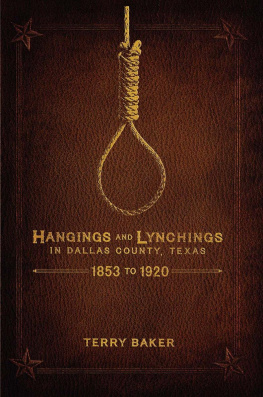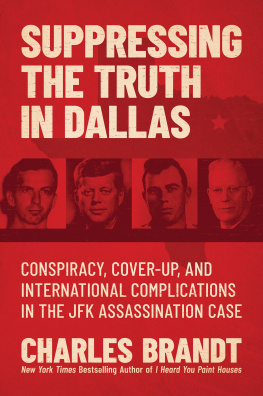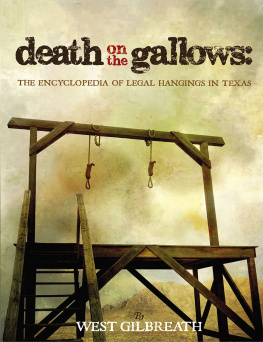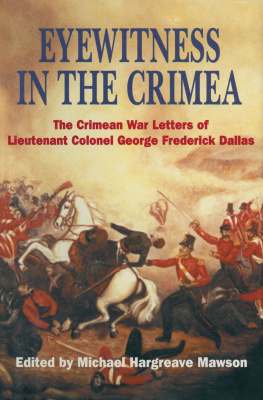Hangings and Lynchings In Dallas County, Texas
1853 to 1920
Terry Baker
| Copyright 2016 By Terry Baker Published By Eakin Press An Imprint of Wild Horse Media Group P.O. Box 331779 Fort Worth, Texas 76163 1-817-344-7036 www.EakinPress.com ALL RIGHTS RESERVED 1 2 3 4 5 6 7 8 9 ebook ISBN 978-1-68179-188-3 Paperback ISBN 978-1-68179-033-6 Hardback ISBN-13: 978-1-68179-032-9 |
Cover Design by Flying Gorilla Studio www.FlyingGorillaStudio.com
This book is dedicated to my father, Henry Hank Baker
1907 - 1982
He grew up as a cowboy in North Dakota, and in 2013 he was inducted into the North Dakota Cowboy Hall of Fame in the Pre-1940 Rodeo category. He shared my passion for stories of the Old West in the 1800s, and the cowboy way of life. He sometimes said he was born fifty years too late, because he missed the great cattle drives of the 1870s from Texas to Kansas, North Dakota, and Montana.
Contents
Acknowledgements
The Texas and Dallas History Archives and the Genealogy Departments at the Dallas Central Library provided much of the research material for this book. I would like to thank all the staff at the library for the assistance they provided me over a period of seventeen years. They offered suggestions on how to locate the many hidden treasures in the library collections that were needed to complete the research. A special thank you to Carol Roark, Sharon Martin, Brian Collins, Bryan McKinney Ed Boehringer, and many others at the Dallas library that made my job easier.
Gratitude is also extended to attorney-at-law Ron DeLord, the Combined Law Enforcement Officers Associations of Texas, and the Texas Peace Officers Memorial Foundation for their support over many years.
I would like to acknowledge the following for their suggestions and assistance: Robert W. Bob Stephens; Bob Alexander, former DEA agent; Donaly E. Brice, Reference Archivist at the Texas State Archives; and Rick Miller, former Dallas police officer, chief of police in Denton and Killeen, and former county attorney of Bell County, Texas. All are noted authors and historians of early Texas law enforcement.
Thanks to my daughter Cheryl, and son-in-law Denny Gorena, for their suggestions, and assistance with computer issues. Also thanks to longtime friends, Jim and Vicki Newman for their help with computer issues. Thank you to Leonard Knight, for his help searching old cemeteries for tombstones to photograph. And thank you to Harold Williams, caretaker, Oakland Cemetery, Dallas. Also thanks to Ed Clark, Dallas County Sheriffs Department.
I want to thank a longtime friend of over thirty years, retired Texas Chief of Police Phil Hambrick, who offered me encouragement to continue my research and document cases of Texas peace officers killed in the line of duty. Part of that research was used in the writing of this book.
And finally I would like to thank my wife Joyce Ann Greear Baker, for her patience and the time she spent with me in the upper floors of old courthouses going through dusty old criminal record books, and for the times we spent in old cemeteries searching for tombstones, and for offering suggestions and proof reading this book.
Methods of Execution
Lynching - aka: Judge Lynch and Lynch Law. Lynching is the illegal hanging of a person under the pretext as a service to justice, or revenge, without the due process of law. Usually the actions of a mob, or vigilantes.
Hanging - The legal execution of a person after a court trial, conviction and sentence to death. An execution could be ordered by a State recognized court of law. Legal hangings in Texas from 1836 to 1924 were conducted by the sheriff in the county where the trial was held, the accused was convicted, and sentenced to death.
Electrocution - In the early 1900s many states in the United States started requiring that executions be conducted by electrocution. During the summer of 1923, the Texas Legislature passed Senate Bill 160, which required that all future executions be held at the Texas State penitentiary in Huntsville. The bill also required that the executions be by electrocution. The first execution by electrocution at the Huntsville prison was on February 8, 1924, when five inmates were executed. The electric chair at Huntsville soon became known as Old Sparky.
Lethal Injection - In 1964 the United States Supreme Court placed a moratorium, or temporary ban on executions. The ban was later lifted in 1976. New statutes were written in an attempt to comply with the Supreme Court ruling. In 1982, Texas resumed executions using the lethal injection method, which is currently in use today. Texas State ordered executions are still held at the State Penitentiary in Huntsville, Texas.
Hangings and Lynchings in Dallas County, Texas 1853 to 1920
by Race and Sex
18 - Black males hanged, and or lynched.
1 - Black female hanged.
9 White males hanged, and or lynched.
28 - Total.
12 Black males hanged after trials.
1 Black female hanged after a trial.
6 Black males lynched by mobs.
3 White males hanged after trials.
5 White males lynched by mobs.
1 White male robbed and then lynched [but he did not die].
28 - Total.
Introduction
Anglo Americans began arriving to settle in what was to become Dallas in the early 1840s. John Neely Bryan first visited in 1839 the place that would one day become Dallas. Bryan returned to Arkansas and settled his affairs, and returned in 1841 and built a small log cabin along the Trinity River. John Beeman arrived in April 1842 with his family, including daughter Margaret. Bryan married Margaret Beeman on February 26, 1843. As he was the first settler, John Neely Bryan became known to some as the Father of Dallas.
Dallas County was created in 1846 from Nacogdoches and Robertson counties. Some believe Bryan named Dallas after his friend, Joseph Dallas, while others said he named the community after U.S. Vice President George Miffin Dallas. As other families came to the area a small community took shape along the banks east of the Trinity River.
At the time, Texas was a slave holder state with slaves legally bought and sold not only in Texas, but throughout the South. Some of the early settlers brought their slaves with them when they arrived in the area.
On March 30, 1846, after the annexation of Texas to the United States, the new Texas State Legislature passed an act creating the county of Dallas. On April 18, 1846, they named the city of Dallas the county seat.
The first Dallas County Courthouse was built in 1846. John Neely Bryan donated an entire block for a courthouse square. It was set in the center of the new town site. The courthouse was a ten foot by ten foot log building, with one door and two windows. It had benches made from logs and although crude, was good enough for a new frontier community. A building was later erected for the clerks of the county and district courts.










